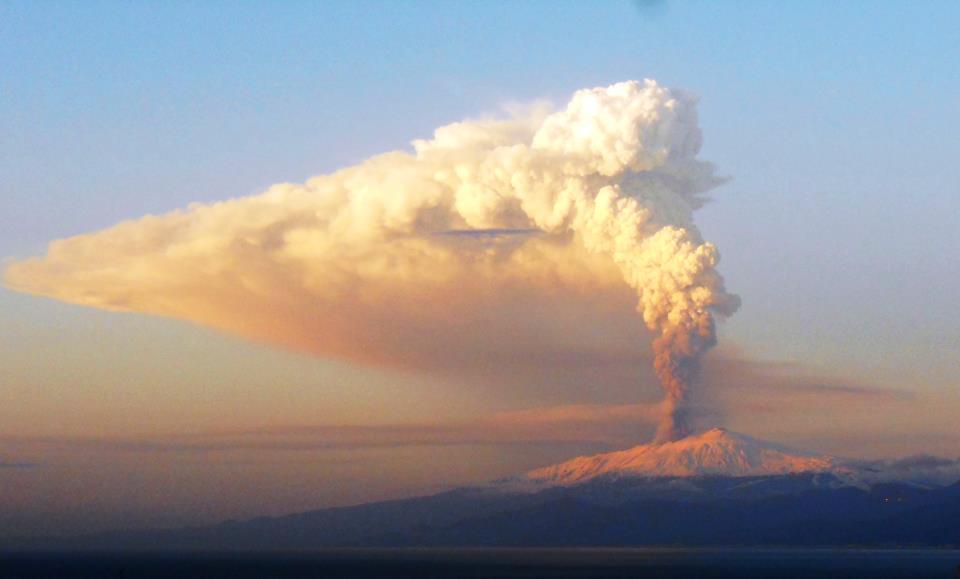28 March 2012
Mount Etna’s fiery fountains measured
Posted by kramsayer

A Jan. 5, 2012, fountain eruption at Mount Etna. Researchers have developed a new way to measure the amount of lava flowing from the volcano. (Credit: Gianni Lanzafame)
Italy’s Mount Etna has had a busy year doing what volcanoes do best — erupting and providing volcanologists and sightseers alike with a fiery show. Armed with a new technique to determine lava volumes, researchers can now add up the amount of material that made up the impressive volcanic displays last year.
Mount Etna released nearly 28 million cubic meters (989 million cubic feet) of lava between Jan. 10, 2011, and Jan. 9, 2012, the scientists discovered. That’s enough lava to fill America’s tallest building, Chicago’s Willis (formerly Sears) Tower, nearly 19 times. Or, it’s enough to fill the Empire State Building about 28 times.
The average lava output of Mount Etna was 0.9 cubic meters per second (about 32 cubic feet per second) during 2011, slightly more than the yearly average rate of 0.8 cubic meters per second (about 28 cubic feet per second) that the volcano previously maintained since 1971. This average is taken over the entire year, not just during eruptions, said Gaetana Ganci, a researcher at the Istituto Nazionale di Geofisica e Vulcanologia and one of the authors of the new study published today in Geophysical Research Letters, a publication of the American Geophysical Union.
“The average output rate of Etna has been constant during the last 30 years, and can result in few high volume lava flows or many low volume lava fountains,” Ganci said.
Mount Etna is known for its lava fountaining (think of a jet of lava bursting through Earth’s crust like a fountain-shaped Fourth of July firework) and strombolian eruptions, which can throw globs of lava and vent volcanic ash hundreds of meters in the air. Both types of eruptions produce lava flows that the scientists measure.

Mount Etna releases a plume of ash thousands of feet into the air on Jan. 5, 2012. (Credit: Gianni Lanzafame)
Researchers in this study estimated lava volumes on the basis of how fast the flows cooled. With Ganci’s method, a satellite-based thermal imager is used to retrieve the change in heat released by Mount Etna’s lava flows. Ganci and her colleagues used data from the Spinning Enhanced Visible and Infrared Imager (SEVIRI) aboard the Meteosat Second Generation satellite system for their measurements.
One problem with this method arises when volcanic ash blocks thermal satellite readings. In previous attempts to quantify lava amounts, this has led to underestimated volumes. To counteract this, Ganci and her colleagues developed equations and theoretical lava-cooling computer models to fill in the gaps. With this new technique, weather conditions and ash clouds will only impact the data if they obscure the lava completely throughout its entire cooling process, she said.
“This new methodology improves our ability to promptly track and document the short, but intense and potentially hazardous, eruptive events,” Ganci explained.
The methods used in the study have applications beyond Mount Etna, the researcher said, and could be applied to any short-lived volcanic event where thermal satellite imagery is available, which allows the lava flows to be measured from afar.
With the new data from Mount Etna, Ganci and her colleagues also created an online geographic information system (GIS) that helps to forecast the volcano’s lava flows and highlight hazard areas around the Sicilian volcano, based on the routes of previous lava outpourings. As more eruptions occur at Mount Etna, more information will be added to the GIS, allowing volcanologists to better track the effects of these eruptions.
You can create your own strombolian eruption and lava fountain online. It might not be as awe-inspiring as the real thing, but it’s certainly safer.
![]()
Ganci, G., Harris, A., Del Negro, C., Guehenneux, Y., Cappello, A., Labazuy, P., Calvari, S., & Gouhier, M. (2012). A year of lava fountaining at Etna: Volumes from SEVIRI Geophysical Research Letters, 39 (6) DOI: 10.1029/2012GL051026
– Eric Villard, AGU science writing intern


 GeoSpace is a blog on Earth and space science, managed by AGU’s Public Information staff. The blog features posts by AGU writers and guest contributors on all sorts of relevant science topics, but with a focus on new research and geo and space sciences-related stories that are currently in the news.
GeoSpace is a blog on Earth and space science, managed by AGU’s Public Information staff. The blog features posts by AGU writers and guest contributors on all sorts of relevant science topics, but with a focus on new research and geo and space sciences-related stories that are currently in the news.
Great article- The research is interesting, and the science is explained very well. I love the reference to the amount of lava from Mount Etna filling the Willis Tower 19 times.
[…] Een continue rookpluim herinnert je eraan dat je op een berg staat die ieder moment kan rommelen. Gemiddeld komt er zo’n 0,8 kubieke meter lava per seconde omhoog. De Etna is zo’n 3300 meter hoog […]